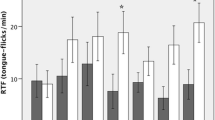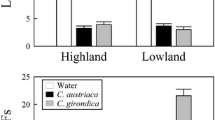Summary
Ingestively naive hatchling coachwhip snakes(Masticophis flagellum) detected integumentary chemicals from several potential prey species and discriminated them from chemical stimuli from other animals and from distilled water, strongly suggesting a genetic basis for these abilities. The strongest responses were to lizard and snake stimuli, which form a major part of the diet. Variable responses to chemical cues from other taxa are discussed. Responses by coachwhip snakes to prey chemicals appear to be highly specific, as suggested by the stronger reaction to vomodors of sympatric than of allopatric lizard species. The highly developed use of chemical cues by the diurnal, visually oriented coachwhip snake emphasizes the general importance of chemical senses to predation by nonvenomous snakes, regardless of the involvement of vision.
Similar content being viewed by others
References
Arnold SJ (1977) Polymorphism and geographic variation in the feediing behavior of the garter snakeThamnophis elegans. Science 197:676–678
Arnold SJ (1978) Some effects of early experience on feeding responses in the common garter snake,Thamnophis sirtalis. Anim Behav 26:455–462
Arnold SJ (1981a) Behavioral variation in natural populations. I. Phenotypic, genetic and environmental correlations between chemoreceptive responses to prey in the garter snake,Thamnophis elegans. Evolution 35:489–509
Arnold SJ (1981b) The microevolution of feeding behavior. Pp 409–453in Kamil AC & Sargent TD (eds) Foraging Behavior: Ecological, Ethological, and Psychological Approaches. New York: Garland STPM Press
Bogert CM (1941) Sensory cues used by rattlesnakes in their recognition of ophidian enemies. Ann NY Acad Sci 41:329–343
Burghardt GM (1966) Stimulus control of the prey attack response in naive garter snakes. Psychon Sci 4:37–38
Burghardt GM (1967) Chemical-cue preferences of inexperienced snakes: comparative aspects. Science 157:718–721
Burghardt GM (1968) Chemical preference studied on newborn snakes of three sympatric species of Natrix. Copeia 1968: 732–737
Burghardt GM (1969) Comparative prey-attack studies in newborn snakes of the genusThamnophis. Behaviour 33:77–114
Burghardt GM (1970a) Chemical perception in reptiles. Pp 241–308in Johnston JW, Moulton DG, Turk A (eds) Advances in Chemoreception, Vol. 1. Communication by Chemical Signals. New York: Appleton-Century-Crofts
Burghardt GM (1970b) Intraspecific geographical variation in chemical food cue preferences of newborn garter snakes (Thamnophis sirtalis). Behaviour 36:246–257
Burghardt GM (1975) Chemical prey preference polymorphism in newborn garter snakesThamnophis sirtalis. Behaviour 52:202–225
Burghardt GM (1977) The ontogeny, evolution, and stimulus control of fedding in human and reptils. Pp 253–275in Kare M, Maller O (eds) The Chemical Senses and Nutrition. New York: Academic Press
Burghardt GM (1978) Behavioral ontogeny in reptiles: whence, whither, and why? Pp 149–174in Burghardt GM, Bekoff M (eds) The Development of Behavior: Comparative and Evolutionary Aspects. New York: Garland STPM Press
Burghardt GM (1980) Behavioral and stimulus correlates of vomeronasal functioning in reptiles: feeding, grouping, sex, and tongue use. Pp 275–301in Müller-Schwarze D, Silverstein RM (eds) Chemical Signals: Vertebrates and Aquatic Invertebrates. New York: Plenum Press
Burghardt GM, Abeshaheen JP (1971) Responses to chemical stimuli of prey in newly hatched snakes of the genusElaphe. Anim Behav 19:486–489
Burghardt GM, Denny D (1983) Effects of prey movement and prey odor on feeding on garter snakes. Z Tierpsychol 62:329–347
Burghardt GM, Hess EH (1968) Factors influencing the chemical release of prey attack in newborn snakes. J Comp Physiol Psychol 66:289–295
Chiszar D, Scudder KM (1980) Chemosensory searching by rattlesnakes during predatory episodes. Pp 125–139in Müller-Schwarze D, Silverstein RM (eds) Chemical Signals: Vertebrates and Aquatic Invertebrates. New York: Plenum Press
Cooper WE Jr (1989a) Absence of prex odor discrimination by iguanid and agamid lizards in applicator tests. Copeia 1989:472–478
Cooper WE Jr (1989b) Prey odor discrimination in the varanoid lizardsHeloderma suspectum andVaranus exanthematicus. Ethology 81:250–258
Cooper WE Jr, Burghardt GM (1990a) A comparative analysis of scoring methods for chemical discrimination of prey by squamate reptiles. J Chem Ecol 16:45–65
Cooper WE Jr, Burghardt GM (1990b) Vomerolfaction and vomodor. J Chem Ecol 16:103–105
Cooper WE Jr, Vitt LJ (1986) Thermal dependence of tongue-flicking and comments on use of tongue-flicking as an index of squamate behavior. Ethology 71:177–186
Cooper WE Jr, Vitt LJ (1989) Prey odor discrimination by the broad-headed skink, (Eumeces laticeps). J Exp Zool 249:11–16
Drummond H (1985) The role of vision in the predatory behaviour of natricine snakes. Anim Behav 33:206–215
Fuchs JL, Burghardt GM (1971) Effects of early feeding experience on the responses of garter snakes to food chemicals. Learn Motiv 2:271–279
Gove D, Burghardt GM (1975) Responses of ecologically dissimilar populations of the water snake,Natrix s. sipedon, to chemical cues from prey. J Chem Ecol 1:25–40
Groves JD (1971) Correlation of certain ophidian sensory modalities with gross brain proportions. J. Herpetol 5:200–204
Halpern M, Kubie JL (1980) Chemical access to vomeronasal organs of garter snakes. Physiol Behav 24:367–371
Henderson RW, Binder MH, Burghardt GM (1983) Responses of neonate hispaniolan vine snakes (Uromacer frenatus) to prey extracts. Herpetologica 39:75–77
Herzog HA Jr, Burghardt GM (1974) Prey movement and predatory behavior of juvenile western yellow-bellied racers,Coluber constrictor mormon. Herpetologica 30:285–289
Hollander M, Wolfe DA (1973) Nonparametric Statistical Methods. New York: John Wiley and Sons
Morris DD, Loop MS (1969) Stimulus control of prey attack in naive rat snakes: a species duplication. Psychon Sci 15:141–142
Schwenk K (1985) On the occurrence, distribution, and functional significance of taste buds in lizards. Copeia 1985:99–101
Siegel S (1956) Nonparametric Statistics for the Behavioral Sciences. New York: McCraw-Hill
Stebbins RC (1985) A Field Guide to Western Reptiles and Amphibians, second edition. Boston: Houghton Mifflin Co
Von Achen PH, Rakestraw JL (1984) The role of chemoreception in the prey selection of neonate reptiles. Pp 163–172in Seigel RA, Hunt LE, Knight JL, Zuschlag NL (eds) Vertebrate Ecology and Systematics — a Tribute of Henry S. Fitch. Lawrence, Kansas: University of Kansas, Museum of Natural History
Weldon PJ (1982) Responses to ophiophagous snakes by snakes of the genusThamnophis. Copeia 1982:788–794
Weldon PJ, Burghardt GM (1979) The ophiophage defensive response in crotaline snakes: extension to new taxa. J Chem Ecol 5:141–151
Winer BJ (1962) Statistical Principles in Experimental Design. New York: McCraw-Hill
Wright AH, Wright AA (1957) Handbook of Snakes of the United States and Canada, vol. 1. Ithaca, New York: Cornell Univ. Press
Wylie SR (1974) A comparison of the ecological niches of coachwhips,Masticophis flagellum (Shaw), and racers,Coluber constrictor Linnaeus, in Texas. Unpublished M.A. thesis, Univ. Texas at Arlington
Author information
Authors and Affiliations
Rights and permissions
About this article
Cite this article
Cooper, W.E., Buth, D.G. & Vitt, L.J. Prey odor discrimination by ingestively naive coachwhip snakes(Masticophis flagellum) . Chemoecology 1, 86–91 (1990). https://doi.org/10.1007/BF01241648
Received:
Accepted:
Issue Date:
DOI: https://doi.org/10.1007/BF01241648




